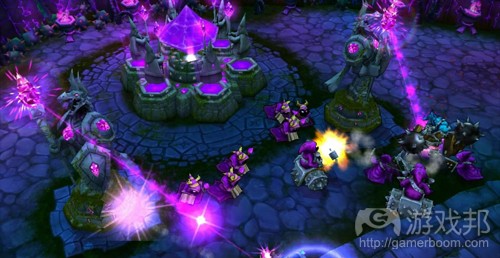分析《英雄联盟》如何改变玩家的不良行为
作者:Christian Nutt
《英雄联盟》至少在两方面十分出众:其一,它证明了免费模式在西方国家的效应,其二,它催生出不良玩家社区。
《英雄联盟》的制作主管Travis George指出,前者无疑是该公司力图长期保持的优势,而后者会损害游戏声誉,限制其发展。
他指出:“没人想和低素质玩家一同体验游戏。”
虽然George知道“一定程度内的”粗俗言语是可取的,“因为任何竞技事件、比赛或游戏中均存在这种情况”,但他也清晰地认识到是时候规范玩家行为。
他表示:“通常会有个度,有些玩家会故意冒犯他人,对他人指指点点,甚至出口诋毁。我想我们应着重改善这些方面。”
但我们该怎么做?
George表示:“其实,我们已经基于此建造了一个解决团队。我们美其名为PB&J团队,即玩家行为与公正协调团队(Player Behavior and Justice Team)。团队由大量人才组成,其中包括两名博士,一位是认知神经系统科学家,另一个是行为心理学家。”
该公司采用高层次专业知识人才与其社区管理人才,共同找出传递更加优良的玩家体验模式的方法。
George表示:“事实上,我们已经发展了某些特定方面,我们设定的指标可以测量玩家在游戏中遭遇消极体验的比重,以及这种消极体验的恶劣程度。之后,我们必须制定规则,或以特殊方式在游戏社区通告并解决这些问题。”
“这将会成为我们的关注重点。”
他表示:“我们之所以这样做,是因为我们认为自己的社区成员十分优秀。有时,单单一个玩家便可摧毁整款游戏,或给其他玩家带来不愉快感受。”
该公司为此设置了惩罚冒犯行为的“Tribunal”法庭。但George与PB&J团队认为,这只能解决一半问题。
George指出:“这不仅仅是设立Tribunal与移除问题玩家这么简单。”PB&J团队还需“激励积极行为,思考人们为何对游戏感到失望。借此,努力修复并解决这些根本性问题。”
George表示,当团队开始调查那些问题玩家行为时,我们的初衷是,“希望玩家不要变成傻子。我们已亲身经历过这些方面。之后我们会总结道:‘我们对这些行为的负面影响又更加了解多少,它会产生哪些负面影响,我们是否更加理解问题的矛头?’”
他指出:“此时,博士研究员可以帮助我们创建这些模型,而后我们可以利用它们跟踪并分析所谓的‘玩家行为’。”
“大部分问题基本上可以通过出色的研究调查与科学技术予以解决。其中关键是你想投入多少时间,而这也是玩家关心的重点。”
该团队之所以努力解决这方面问题,是因为先前全球调查指出,《英雄联盟》中玩家的冒犯行为已成为“世界性问题”。George指出:“我们看到大家都在探讨这个问题。因此,我们应首先解决它。”
“我认为,这对整个团队而言十分重要,而且我们团队是由跨领域人才组成,包括博士、游戏设计师、工程师、制作人,他们从各个方面支持着这项工作。你会惊讶地发现,该游戏设计包含了大量博士研究成果。”(本文为游戏邦/gamerboom.com编译,拒绝任何不保留版权的转载,如需转载请联系:游戏邦)
League of Legends: Changing bad player behavior with neuroscience
by Christian Nutt
League of Legends has become well known for at least two things: proving the power of the free-to-play model in the West, and a vicious player community.
The former is nothing the company wants to change, but lead producer Travis George knows that the latter is hurting the game’s reputation and hemming in its potential to grow.
“Nobody wants to play a game with somebody who’s mean,” he says.
While he recognizes that “a decent amount” of trash talking is okay, “because that exists in every competitive event, sport, game ever,” he also knows it’s time to clean up player behavior.
“There’s a line, and that line generally is people being mean for the sake of being mean — telling you what to do, telling you how bad you are. And I think we can actually fix a lot of that,” he says.
But how?
“We actually have built a team around this, to address it,” George says. “We call it, lovingly, the PB&J Team, which stands for Player Behavior and Justice Team. And there’s a lot of really talented folks on that team, including two PhDs. One’s a cognitive neuroscientist and one’s a behavioral psychologist.”
The company is using a mixture of high-level expertise (the academics with the fancy degrees) and its community expertise to figure out how to deliver a better player experience.
“We’ve actually developed specific trends, and our own set of metrics that we look at for measuring what percentage of times we think that players will encounter a negative experience in a game, and how severe that negative experience is,” says George. “And then we have to build things or be responsive or message the community in a particular way to address those things.”
“This is going to be a major focus for us,” says George.
“One of the things that makes us want to do it most is we think we actually have a really great community,” he says. “And sometimes it only takes one person to ruin a game or create a really negative experience for a lot of other people.”
The company’s “Tribunal”, in which offending players get penalized, has gotten a lot of ink, including on Gamasutra. But George and the PB&J team think that’s just one half of the answer.
“It’s not only Tribunal and removing players,” says George. The PB&J Team’s goal is also “incentivizing positive behavior, and thinking about why people are upset in those games. So, trying to fix those and address those root problems.”
When the team started researching problematic player behavior, says George, it came from a sentiment at Riot of “we don’t like players being jerks in games,” says George. “We’ve experienced it all ourselves. But then, we actually sat down and said, ‘How do we actually more tangibly understand how bad the impact is, or what the impact is, or understand the problem more?’
“And that’s where you’ve got guys who are PhD researchers who can help develop those models, and we have, actually, those models for how we track and trend what we call ‘player behavior,’” George says.
“You can apply really good research and science techniques to almost anything,” he says. “The trick is just finding what you want to actually spend the time on, and that’s where the sentiment for players comes in as a huge guiding factor to that.”
The team decided to put real effort into it when global player sentiment surveys unveiled that player behavior was a “worldwide problem” for League of Legends. “We see it talked about everywhere. And so, those are the type of things that we generally gravitate towards,” George says.
“We think it’s a great addition to the team, and that team is actually cross-discipline, so it’s got the PhD guys, game designers, engineers, production support all working together from a variety of perspectives. You’d be surprised how much the game design intermingles with the PhD research.”(source:gamasutra)








































 闽公网安备35020302001549号
闽公网安备35020302001549号